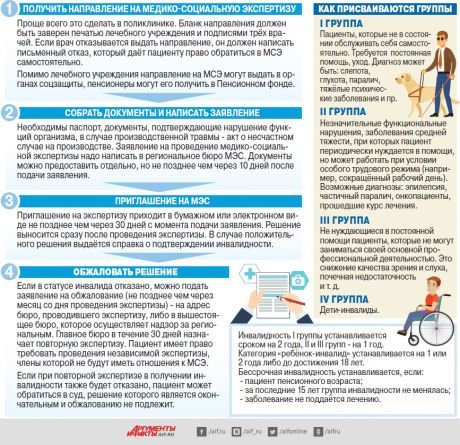Application for ITU: form and filling rules
An application for participation in a medical and social examination is submitted by a person applying for a disability determination. ITU will review your application and the documents attached to it and determine the degree of impairment of your health, your ability to work and the technical equipment and prosthetic and orthopedic products necessary for rehabilitation.
Here is the application form:
How to fill out the application correctly:
All fields must be filled out legibly, without blots or any corrections. If you are not sure, fill in block letters. Just in case, have a couple of forms ready to rewrite if you mess one up.
The last name, first name and patronymic are written in full, the passport data is filled in on the identity card: series and number, place of issue (name and unit code), date when the passport was issued. The residential address is written according to the registration in the passport. In the column for the purpose of the appeal, “establishment of disability” is written. If you require the services of a sign language interpreter, please highlight the appropriate line in the application.
| Note! At the bottom of the application there are four options for inviting you to the commission: in person, by mail, by phone or by email. Keep in mind that mail can let you down; it is much safer to choose the method of informing by phone. |
If the application is filled out by a representative of a disabled person, then it is necessary to indicate a document confirming his authority. If you represent the interests of your child, it is enough to indicate the birth certificate; if you represent an adult, a power of attorney or details of a document confirming guardianship.
Samples of filling out forms:
A completed application for ITU is submitted in person or through a representative to the office at your place of residence. You can send it by mail or through the State Services portal.
| Important! If you submitted an application electronically, you must provide the direction and originals of all necessary documents within ten days, otherwise the application will be rejected. |
List of diseases for which disability is given
Making a positive decision on the assignment of disability depends not on the presence of a particular disease, but on the nature of its development and the impact of the diagnosis on the physical and social capabilities of the person applying for disability. Therefore, the ITU commission makes a verdict based on objective information about the patient’s health status.
However, in case of some defects, injuries and disorders of the normal functioning of the body, a disability group is assigned on a permanent basis, freeing the person from the need for periodic re-examination of his status. Among them:
- malignant tumor (with spread of metastases, with relapses);
- neoplasms in lymphoid and hematopoietic tissues (with intoxication and severe condition);
- neoplasms in the brain and spinal cord (not amenable to surgical removal);
- dementia of congenital and acquired nature;
- progressive diseases of the central nervous system, resulting in disorders of speech, vision and movement;
- neuromuscular diseases with a progressive course;
- visual defects;
- presence of complete deafblindness;
- high blood pressure, causing complications of the central nervous system, heart muscles and kidneys;
- some types of coronary heart disease;
- respiratory tract defects with complications in the form of persistent respiratory failure and circulatory failure;
- defects in the development of the skeletal and muscular systems with impaired support and motor functions, if correction is impossible;
- defects caused by injury to the brain or spinal cord, expressed by impaired speech, vision, movement or dysfunction of the pelvic organs;
- limb defects.
Attention! Other diagnoses are the reason for assigning disabled status if an examination confirms such a need.
The decision to assign the status of “disabled” after a stroke is made at the discretion of ITU experts, who assess the severity of the health condition, the type of stroke (ischemic or hemorrhagic), the effect on internal organs, the dynamics of the development of consequences, as well as the general condition of the patient.

A heart attack does not always become the basis for assigning a disability group. The presence of visual defects significantly affects the quality of life and the ability to lead full life activities, therefore, in some cases, defects of the visual system are considered the basis for the assignment of disability. The first group is assigned to patients who are blind in two eyes or persons whose visual acuity does not exceed 0.04. The second disabled group is received by patients with an acuity of 0.05-0.1. Group 3 can be assigned to those whose visual acuity falls in the range of 0.1-0.3.
Also, based on the results of the examination, a person can be recognized as disabled on an individual basis due to some operations that have resulted in the amputation of an arm or leg, as well as in situations where no positive dynamics are observed as a result of surgical intervention.
The disability group is determined based on data on the severity of disorders in the patient’s body.
The first disability group is given to those who do not have the ability to support their own life activities. Such patients include bedridden and non-ambulatory patients, people with mental retardation who are unable to care for and serve themselves. Such people constantly need help from outsiders.
The second disability group is assigned to patients with diseases of moderate severity. Such patients do not require constant care, and under certain circumstances they can carry out work activities in compliance with certain rules. This group can be assigned to partial hearing loss, visual impairment, frequent attacks of epilepsy, etc.
The third group is defined for patients who can take care of themselves, but are no longer able to carry out their main professional activities.
Messenger (bypass) sheet for the ITU and what should be in it
The application for medical examination must be accompanied by medical documentation confirming persistent health problems, including a conclusion from a medical institution. To receive it, the patient is given a messenger (bypass) sheet. It contains all the patient’s data: last name, first name, patronymic, date of birth and home address. Notes are made on the sheet whether the patient is undergoing the commission for the first time or repeatedly, whether he is working or not, and information about the nature of his work.
Further, the parcel sheet contains information on the medical history and treatment performed. How many times during the year was temporary disability established (sick leave issued). The doctor must indicate the main diagnosis and concomitant diseases, the patient’s need for rehabilitation programs and medications. The conclusions of narrow specialists are indicated, including an assessment of the patient’s physical and mental state. At the end, a prognosis and recommendations for determining disability are given.
| Important! The form of the mailing list must be certified by the seal of the clinic or hospital, it must contain the signatures of doctors and the date of completion |
Mailing slip form (new form 088-u, approved from December 2021):
What to do if your doctor refuses to issue a referral for medical examination? In this case, you need to request a written refusal. To do this, contact the head of the clinic with a free-form application for issuing a reasoned refusal to refer you to the ITU. In the application, indicate your details, contact phone number, name of the doctor who refused to give you a referral and the method in which you would like to receive an official response.
Do not be discouraged if you are unable to get the required referral from the clinic, you can contact the ITU yourself. We wrote about this in the article “How to register a disability: necessary documents and tips for passing the commission.”
If you have any questions about this topic or have any additions, write about it in the comments!
You can find more detailed information in these articles:
Passing the ITU
When all the necessary documents have been submitted, you need to get in line. Then the applicant is assigned a time for a meeting of the ITU commission. As usual, the waiting period for examination is no more than 30 days from the date of registration of the application at the ITU department.
Examination procedure
The ITU commission usually consists of three experts: they examine the patient, ask questions about the state of health, and sometimes about the financial situation of the person applying for disabled status. Members of the ITU commission can ask questions related to the patient’s living conditions, his social skills, and education. Experts have the right to demand the presentation of a reference from the organization in which the patient works.
The following criteria must be met:
- A person must be limited in his life activities. Such a person is unable to move without assistance, is unable to control behavior or care for himself;
- The applicant has a need for rehabilitation measures, including adaptation to society;
- Manifestation of a persistent pathological condition of internal organs;
Often a patient is assigned disabled status even if two points are met.
All questions asked and answers must be recorded in the minutes of the meeting. The experts then vote. If controversial issues arise or specialists disagree, the commission prescribes additional medical tests and examinations. Upon completion of the MSA, the patient receives a documented report. When a disability group is approved, the patient is prescribed a rehabilitation course and is given a list of certificates required by the pension fund and social services, where the disability pension and other benefits are processed. How long you will have to wait for your status to be issued depends on the specific situation, but usually all the necessary documents are ready no later than 3 days after the examination.









